#802 Cutting Simon Fraser down to size
Lowering Simon Fraser
by Maddie Leach (concept and editing) and Michael Kluckner (drawings and interpretation)
Vancouver: Contemporary Art Gallery, 2019
[catalogue; no price] / 9781989503027
Lowering Simon Fraser (the catalogue) is available from the shop at the Contemporary Art Gallery
Reviewed by Forrest Pass
*
 1908 should have been a bumper year for commemorations in British Columbia. Throughout North America before the First World War, virtually any anniversary warranted a statue, a plaque, or a historical pageant. And 1908 offered British Columbians several options to choose from.
1908 should have been a bumper year for commemorations in British Columbia. Throughout North America before the First World War, virtually any anniversary warranted a statue, a plaque, or a historical pageant. And 1908 offered British Columbians several options to choose from.
Chief among these was the fiftieth anniversary of the Fraser River gold rush and the founding of the mainland colony in 1858. One local journalist proposed a celebration to boost tourism — and promote historical literacy. “How many of the present generation can even name the men who formed the advance brigade of the gold seekers,” lamented columnist “C.H.G.” of the Victoria Colonist.
Today, no doubt, a Historica-Dominion Institute survey could furnish C.H.G. with a precise index of historical ignorance. In 1908, the failure of anyone else to take up his pageant project was answer enough. It was not, however, that C.H.G.’s compatriots were numb to the clarion call of historical pageantry; rather, a louder clarion sounded beyond the Rockies.
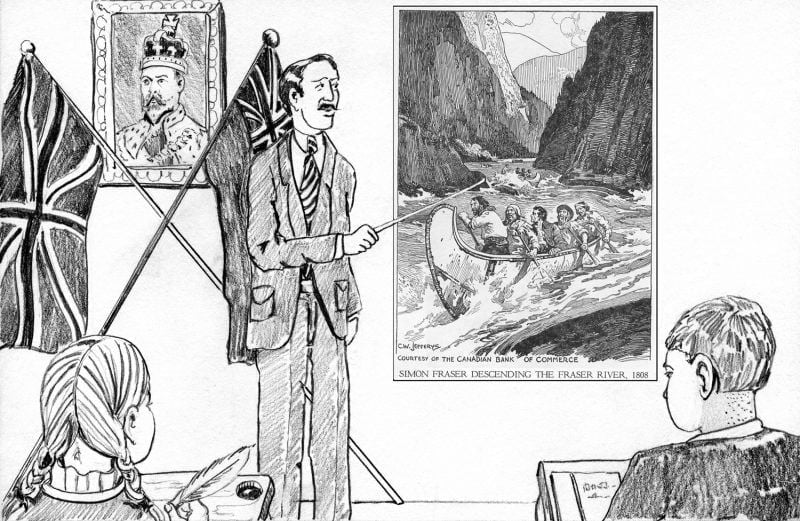
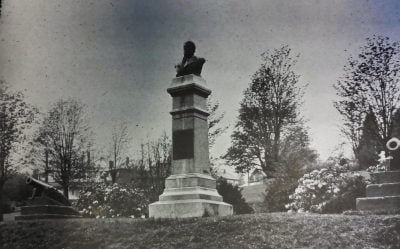
The three hundredth anniversary of the founding of Quebec City (1608) prompted the largest Canadian commemorative spectacle before the Diamond Jubilee of Confederation in 1927, and British Columbians joined Canadians everywhere in marking the event. In BC schools, children donated their milk money to help purchase the Plains of Abraham for a national historic park. The Canadian Club of Vancouver shelved its plans for a statue of Captain George Vancouver and instead supported a scheme to honour General James Wolfe at his gravesite in England. For many Edwardian British Columbians, it seemed, “history” happened elsewhere.
Yet a third anniversary did warrant a local monument, albeit a modest one. In New Westminster, local boosters erected a stone monument to Simon Fraser to mark the centenary of the explorer’s 1808 descent of the river that now bears his name. An exhibit organized by the Provincial Archives coincided with the unveiling; an anticipated historical pageant, inspired by the Quebec Tercentenary festivities and to feature both Indigenous and settler performers, was cancelled for lack of funds. A bronze bust was added in 1911.
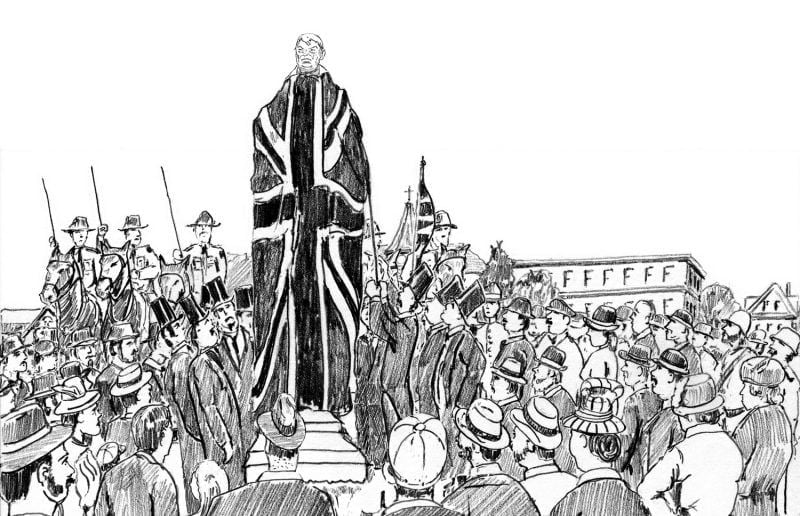
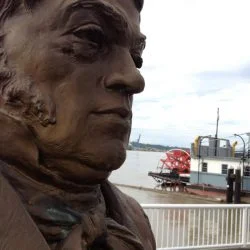
The Fraser monument still stands, though it has been relocated twice; today it is closer to the river and on a shorter plinth than when it was unveiled. And if an innovative public art project had unfolded as initially planned, that plinth might today have been shorter still.
New Zealand artist Maddie Leach became fascinated with the story of the Simon Fraser monument, and how its “unacknowledged ‘lowerings’” presaged the present-day movement to reconsider colonial historical commemoration. During a residency at the Contemporary Art Gallery’s Burrard Marina Field House, Leach researched the history of the monument and approached New Westminster City Council with a proposal to lower Simon Fraser one more time, by removing a slab of granite from its plinth and “returning” the stone to the headwaters of the Fraser River, whence it would — over years, centuries, or even millennia — erode and retrace Fraser’s descent.
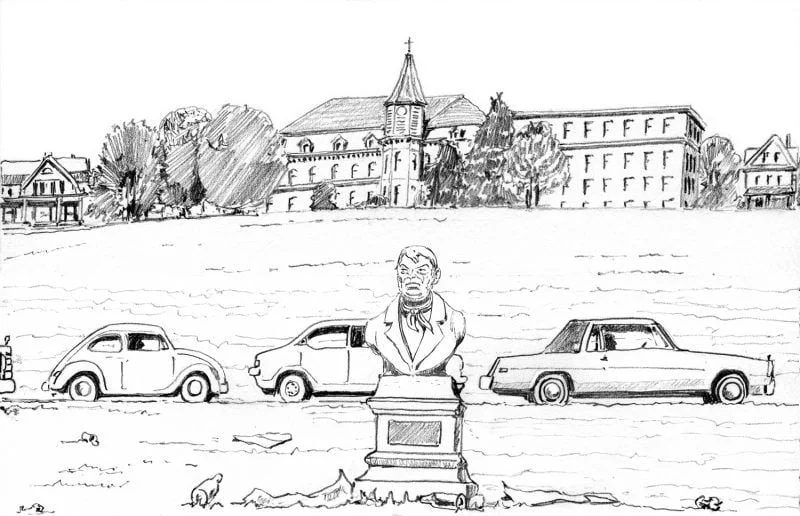
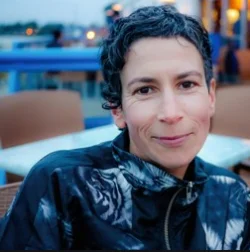
Like the elaborate plans for the 1908 Fraser commemoration, Leach’s project of permanently altering the Fraser monument ultimately proved impractical. Instead, for a few days in the autumn of 2019, she temporarily painted a portion of the plinth to represent the lowering of the monument. A billboard above the Queensborough bridge complemented this symbolic dethronement, as did a limited-edition booklet that contextualizes the project through the illustrations of artist and heritage advocate Michael Kluckner.
This short companion volume is delightful. Through a textless graphic narrative in the spirit of Lynd Ward’s Wild Pilgrimage, Kluckner playfully recounts the successive “lowerings” of the Fraser bust. Each time, an overturned-canoe-turned-Chinook-helicopter effects the move. In the final pages, he imagines not only Leach’s proposed alteration to the monument but also the ultimate lowering of Fraser — under the rising waters of “his” river.
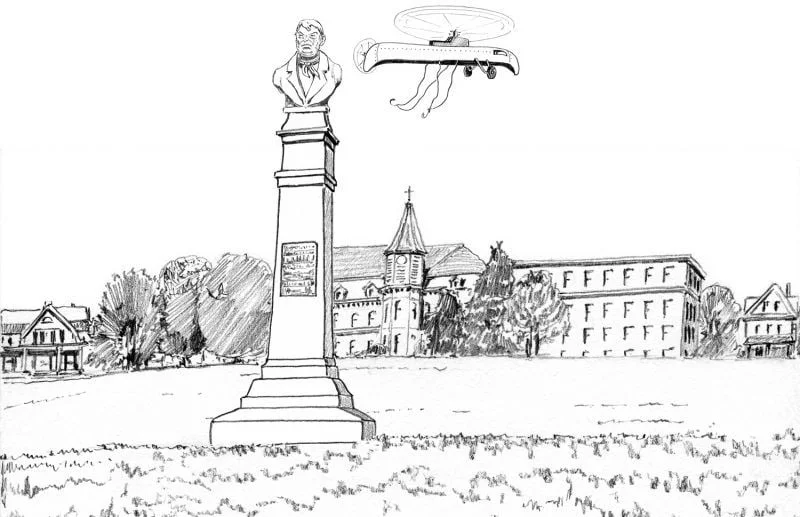
In Kluckner’s version of the Simon Fraser story, the bust itself, and not the flesh-and-bone explorer, commands the 1808 expedition. This brilliantly parodies the most conservative defenders of controversial monuments, for whom their subjects become “the flesh made bronze.” If the monument is a relic of a historical figure himself (or occasionally herself), to move or reinterpret a monument is at best an affront, and at worst an attempt to erase history. Yet the case of the wandering Fraser bust underlines that monuments are not timeless embodiments of the figures and events they commemorate, but, like history itself, subject to continuous repositioning and reinterpretation.
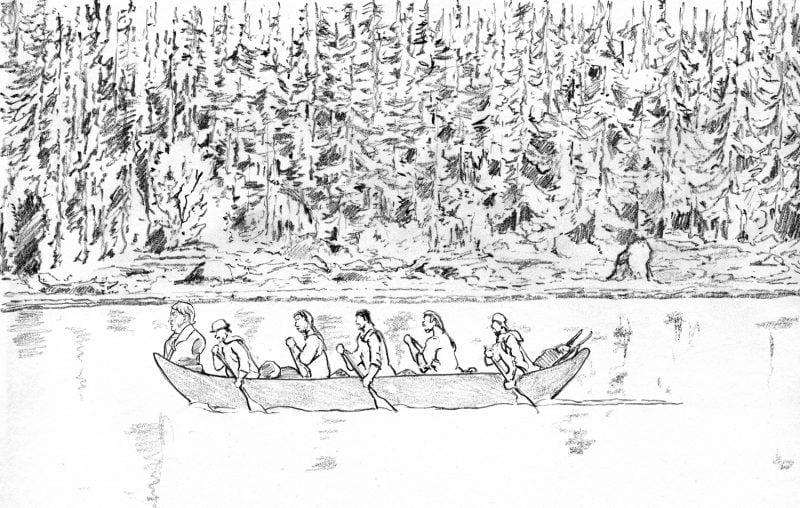
There are, of course, plenty of reasons to reconsider Fraser and his legacy. Kluckner’s final imagining of Fraser’s monument as a victim of climate change seems apt, given that the rapaciousness of fur-trade resource colonialism prefigured the runaway exploitation of the petroleum era. It was certainly not lost on those who erected the Fraser memorial that his explorations set the stage for later colonial settlement, though they undoubtedly saw this as cause for celebration rather than critical reflection. Moreover, as Wendy Wickwire’s analysis of Nlaka’pamux contact narratives reveals, Fraser’s treatment of Indigenous women does not cast him as an explorer for the #MeToo era.
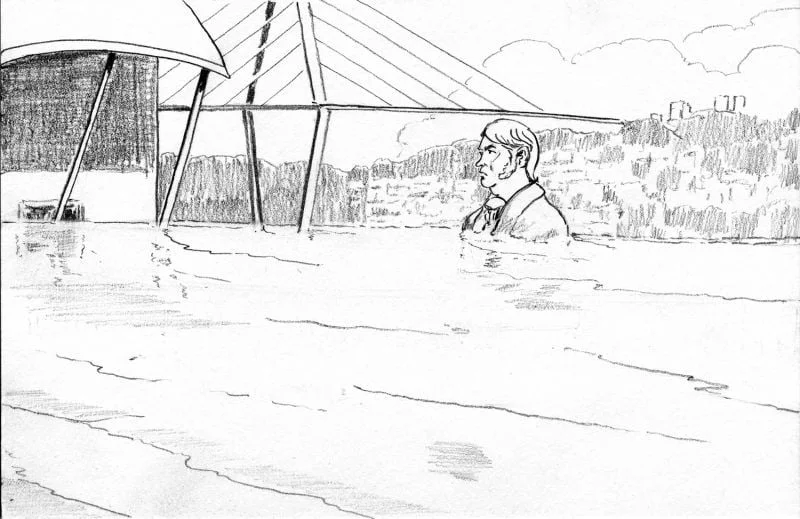
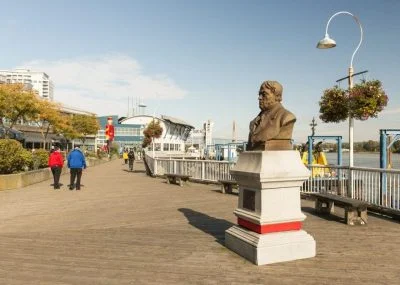
Yet there are also good reasons to keep the bust on public display. The history of contact, conflict, and cooperation in the Cordilleran fur trade is one still worth telling, albeit in a more critical and less heroic way than we told it a century ago. Moreover, the bust itself is an artifact of the first draft of British Columbia’s settler history. “Those who hurriedly declare that this coast has yet to make history are mistaken,” declared the New Westminster Daily News in recounting the modest Fraser centenary celebrations, “and there is in it the making of speaking scenes as good as the recent Quebec [Ter]centenary.” New Westminster’s Fraser bust was a rare west-coast commission for the celebrated Quebec sculptor Louis-Phillippe Hébert, whose works are fixtures of many public spaces of eastern Canadian cities, including the lawns and terraces of Parliament Hill. The monument proclaimed that British Columbia had a romantic settler history as worthy of celebration as that of the eastern provinces — a small salvo in perennial federal-provincial negotiations and interregional rivalries.
Although the case of the Fraser bust demonstrates that rethinking and repositioning monuments is nothing new, we are presently in a singular moment in the history of commemorative politics. Commemorations, like funerals, are for the living rather than the dead, and it is the prerogative of each generation to re-evaluate the commemorative priorities of its predecessors. However, simply removing or renaming a problematic memorial misses an opportunity. Before encountering Lowering Simon Fraser, my favourite example of a commemorative project that succinctly and accessibly conveys history’s complexity has been a plaque erected in 2015 at the grave of poet and bureaucrat Duncan Campbell Scott in Ottawa’s Beechwood Cemetery, a few blocks from my home.
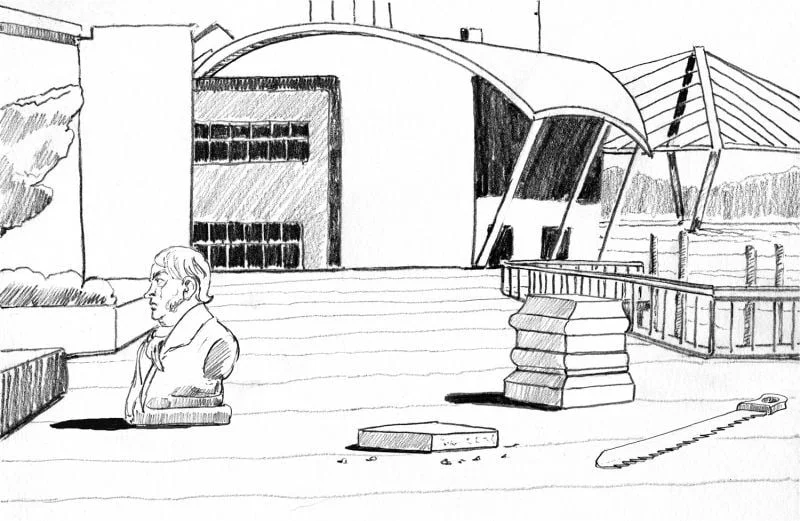

In fewer than one hundred words, that plaque weighs Scott’s literary contributions against his role in developing the notorious Indian residential school system. Leach and Kluckner bring a similar thoughtfulness and creativity to their engagement with Simon Fraser, and may well be my new favourite example. By contextualizing and modifying an existing monument, they reveal the capacity of monuments to tell very different stories from those that their proponents had intended. Indeed, as history teaching becomes as much about process and perspective as about firsts and facts, those intentions become an integral part of the story. Given the pertinence of the project, it is a pity that the monument itself bears no permanent mark of the explorer’s latest “lowering.”
Perhaps this, too, might change. New Westminster City Council approved Leach’s request to cut Fraser down to size, just as the city- and provincial fathers of a century ago supported the monument’s initial erection. The City, or another patron, would do well to print a selection of Kluckner’s illustrations on a series of interpretive panels along the New Westminster Quay, to present this most recent chapter in the Fraser bust story. Time will tell if there is a suitable substrate sturdy enough to resist that rising river.
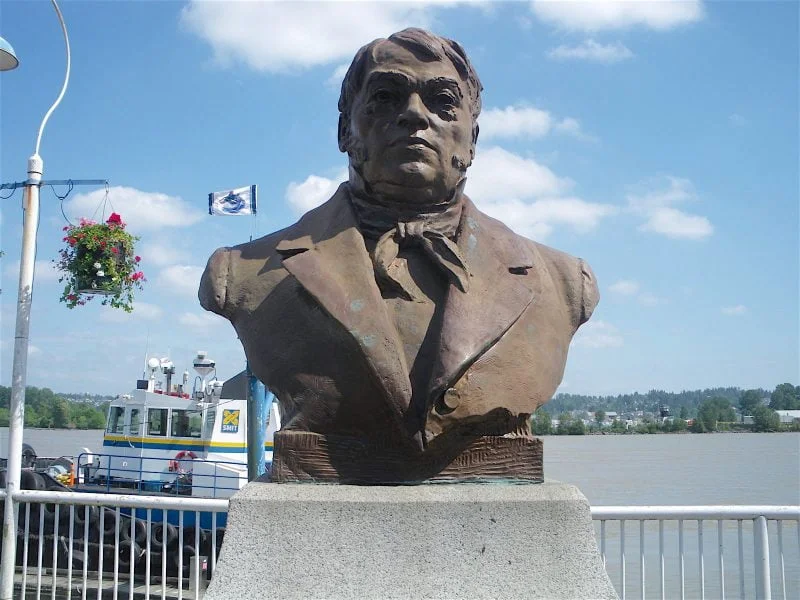
*

Forrest Pass is a curator in the Exhibitions and Online Content Division at Library and Archives Canada. A cultural and material historian with an interest in commemorative practices, his 2006 research on the Native Sons of British Columbia, who commissioned the Simon Fraser bust, is available online here. Originally from the Sunshine Coast, these days he socially-distances in Ottawa.
*
The Ormsby Review. More Books. More Reviews. More Often.
Publisher and Editor: Richard Mackie
The Ormsby Review is a journal service for in-depth coverage of B.C. books and authors. The Advisory Board consists of Jean Barman, Robin Fisher, Cole Harris, Wade Davis, Hugh Johnston, Patricia Roy, David Stouck, and Graeme Wynn. Scholarly Patron: SFU Graduate Liberal Studies. Honorary Patron: Yosef Wosk. Provincial Government Patron since September 2018: Creative BC
“Only connect.” – E.M. Forster
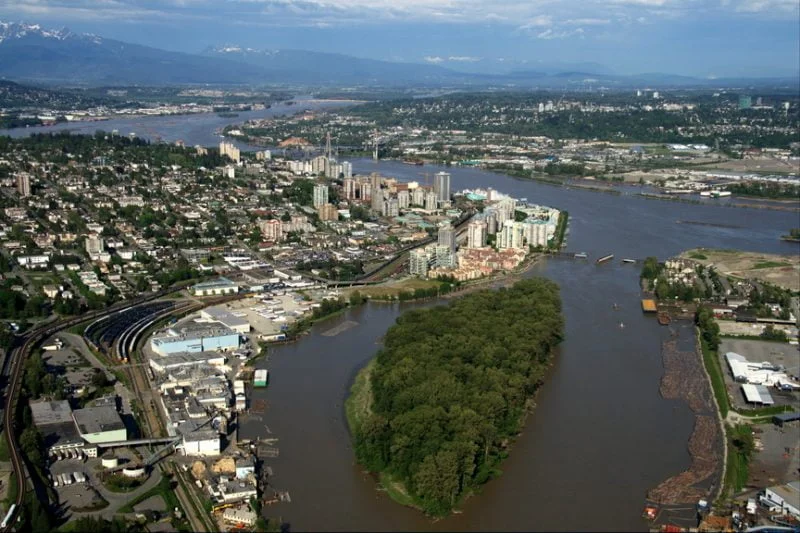















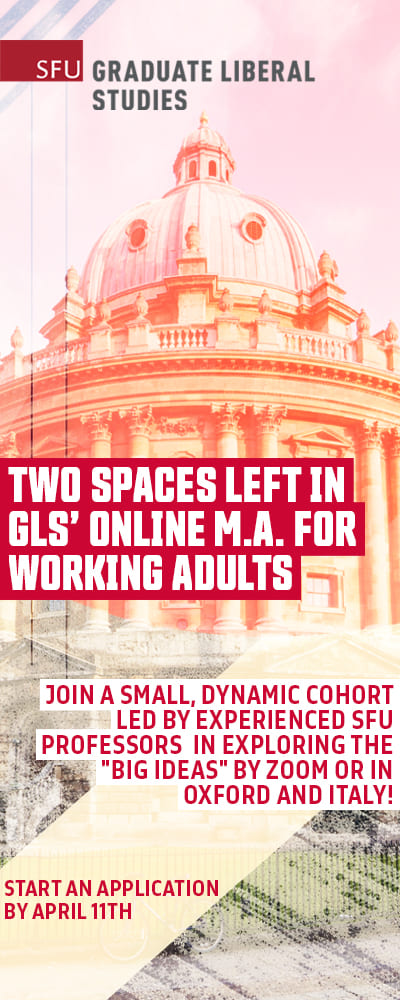















2 comments on “#802 Cutting Simon Fraser down to size”